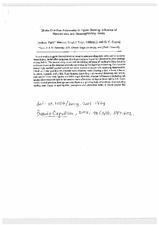| dc.creator | Vaid, Jyotsna | |
| dc.creator | Singh, Maharaj | |
| dc.creator | Sakhuja, Tripti | |
| dc.creator | Gupta, G.C. | |
| dc.date.accessioned | 2016-07-20T23:46:34Z | |
| dc.date.available | 2016-07-20T23:46:34Z | |
| dc.date.issued | 2002 | |
| dc.identifier.citation | Brain and Cognition, 2002, Vol. 48(2/3), 597-602. | en |
| dc.identifier.uri | https://hdl.handle.net/1969.1/157174 | |
| dc.description.abstract | Recent studies suggest that asymmetries noted in certain nonlinguistic tasks used in laterality studies (e.g., facial affect judgment, line bisection) may in part be influenced by prior reading/writing habits. The present study examined the relative influence of reading/writing direction and handedness on the direction of stroke movement in free-hand figure drawing. One hundred twenty right and left handed brain-intact adult readers of scripts with opposing directionality (Hindi vs Urdu) and illiterate controls were observed while drawing a tree, a hand, a house, an arrow, a pencil, and a fish. Right-handers (including right-handed illiterates) and left-to-right readers drew most figures in a left-to-right direction, whereas left handers (including left handed illiterates) and right-to-left readers more often drew the figures from right to left. These results extend previous findings and contribute to a growing body of evidence demonstrating reading scan biases in nonlinguistic perception and production tasks. It would appear that reading/writing habits cannot be ignored as a potential artifact in studies of hemisphere functional asymmetry employing nonlinguistic stimuli. | en |
| dc.language.iso | en_US | |
| dc.publisher | Elsevier | |
| dc.subject | reading direction, scanning, figure drawing, Urdu, biomechanical, handedness, directionality, script | en |
| dc.title | Stroke direction asymmetry in figure drawing: Influence of handedness and reading/writing habits | en |
| dc.type | Article | en |
| local.department | Psychology | en |
| dc.identifier.doi | 10.1006/brcg.2001.1424 | |


